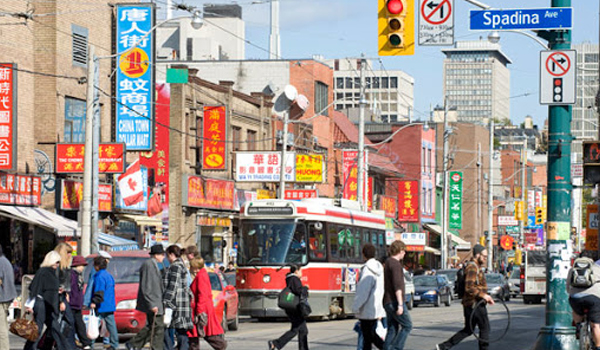中英对照:过去40年来,加拿大的华人社区发生了很大变化
Chinese communities in Canada have changed a lot in last 40 years
来源: Bob Mok

本文是关于加拿大华人移民系列文章的一部分。通过观察和分析,我们期望找出将华裔分成两个不同阵营的原因。有关这一话题的早期文章,请点击http://chinesenewsgroup.com/news/670514
This article part of a series on the subject of immigration by people of Chinese heritage to Canada. From this narrative, we can examine the reasons for the splitting of diasporas into two different camps. For the earlier article, click here: http://chinesenewsgroup.com/news/670514
今天你也许关心的话题:
想要阅读与本文有关的话题?请点击本文末的链接!
1967年,加拿大放宽了《移民法》。这给亚洲国家的人移民加拿大打开了大门。当年,我家抓住这一机会,于1967年移民加拿大。1973年,加拿大对那些在加拿大居住的人大赦,允许他们移民。当时许多留学生获得移民身份,并在移民后把他们的家人接到加拿大。由于当时中国大陆仍是一个“封闭社会”,中国大陆公民与此移民机会无缘。
After Canada relaxed the Immigration Act in 1967, the gates to Canada were opened and immigration from Asian countries became viable once again. This led to my family's immigration in 1967 – one of the first to take advantage of this opportunity. Then came the Canadian Immigration Amnesty Program in 1973 when many students became immigrants and eventually sponsored their families to Canada. Mainland China was left out of this opportunity since it was still a “closed society” at that time.
1975年4月30日,越共占领了南越的西贡。加拿大随即宣布接受来自越南的难民。结果,在1975年和1976年间,加拿大接纳了6,500多名越南政治难民。其中有3,000人在加拿大没有亲戚。
After Saigon fell to the Communist from North Vietnam on April 30, 1975 Canada announced that it would be accepting refugees from Vietnam. As a result, over the years 1975 and 1976, Canada welcomed over 6,500 Vietnamese as political refugees; 3,000 of them had no relatives in Canada.


1978年开始,100多万越南难民坐着那些不能远航的船只逃离越南,并希望在公海上被国际社会营救。这些俗称为“船民”的难民中很大一部分(40%)是华裔。 1979年和1980年,加拿大接纳了60,000名来自印度支那的难民。在整个1980年代,加拿大继续欢迎印度支那难民,总共有约20万来自越南,柬埔寨和老挝的难民在加拿大定居。在所有接受此类难民的国家中,加拿大排第一。这些难民中的许多人是华裔,他们的母语为广东话。我的许多朋友都是那段时间从越南抵达加拿大的华裔。
Starting in 1978, over 1 million people departed Vietnam aboard unseaworthy makeshift vessels, hoping to reach international waters and be rescued there. Collectively known as “Boat people”, a large proportions (40%) of these refugees were of Chinese ethnic origin. In 1979 and 1980, Canada accepted 60,000 Indochinese refugees. Throughout the 1980's, Canada continued to welcome Indochinese refugees. In total, some 200,000 Vietnamese, Cambodians and Laotians have been resettled in Canada — the highest rate per capita among all of the countries that have accepted such refugees. Many of these were of Chinese origin speaking Cantonese as their mother tongue. Many of my friends were Vietnamese Chinese who arrived in Canada during this period.
分享不同信息/观点,做明智判断/决策!请点击096.ca
分享不同信息/观点,做明智判断/决策!请点击096.ca
香港到加拿大的最大移民浪潮发生在1980年代末和1990年代初。起因是1997年中国从英国手中收回香港,许多港人对北京没有信心。从1991年到1996年,每年大约有30,000名香港人移民加拿大,占香港向其他国家移民的一半以上,并占当年加拿大移民总数的20%。这些香港移民中的绝大多数定居在多伦多和温哥华地区,因为在这些城市中有相当规模的华人社区。香港回归后,香港移民人数急剧下降,可能表明港人看好香港的政治稳定。
The largest wave of immigration to Canada from Hong Kong occurred during the late 1980's and early 1990's, as a result of the uncertainties concerning the transfer of sovereignty of Hong Kong from Britain to China in 1997. From 1991 to 1996, about 30,000 Hong Kongers emigrated annually to Canada, comprising over half of all Hong Kong emigration to other countries and about 20% of the total number of immigrants to Canada. The great majority of these people settled in the Toronto and Vancouver areas, as there are well-established Chinese communities in those cities. After the Handover, there was a sharp decline in immigration numbers, possibly indicating a smooth transition towards political stability.


回归后的那几年,许多香港移民因在加拿大难以找到工作而又返回香港回。截至2014年,香港成为加拿大公民在亚洲最集中的地方。约有30万,不同族裔的加拿大公民居住在香港。令人惊讶的是,在过去十年中,每年只有不到1000人从香港移民到加拿大。想当初,人们所说的加拿大华人团体都不是来自中国大陆。这些团体要么受到中共的打压,要么担心被中共打压。
In the years to come, the unemployment and underemployment of many Hong Kong immigrants in Canada prompted a stream of returning migrants. As of 2014, Hong Kong has the highest concentration of Canadian citizens in Asia, with approximately 300,000 Canadian citizens of all ethnic backgrounds living in the city. Amazingly, less than 1000 people from Hong Kong emigrated to Canada each year over the last decade. So far, the groups of Chinese Diasporas we talked about are all coming from locations outside of Mainland China and they are either oppressed by Communist regimes or they are afraid of such scenarios.
1989年,天安门事件(俗称“六四事件”)发生后,许多当时在加拿大留学和工作,来自中国大陆人决定移民加拿大。他们当中许多人反共,也有些人只是简单地利用这个机会留在加拿大。从那时到2005年,中国成为加拿大移民的最大来源。中国大陆平均每年有超过30,000的人移民加拿大,占加拿大每年移民人数的15%。2005年中国移民达到顶峰,有40,000多人移民加拿大。
In 1989, many of the Chinese mainland students and workers decided to stay in Canada after the Tiananmen Square Incident, commonly known as the June Fourth Incident. Many of these people are opposed to the Communist regimes. Some just simply take advantage of that chance to stay in Canada. From that time until 2005, China has taken over from all countries and regions as the country sending the most immigrants to Canada. The Chinese Mainlanders averaged well over 30,000 immigrants per year, contributing an average of 15% of all immigrants to Canada with an all-time high of more than 40,000 reached in 2005.


在过去的十年中,中国一直是每年移民加拿大的三大来源国之一。另外两个是印度和菲律宾。今天,华人在加拿大的公民和居民(180万)占加拿大人口的5%以上。非官方统计估计,中国大陆移民占加拿大华裔人口总数的一半。
Over the last decade, China was consistently one of the top three countries of origin for immigrants coming to Canada every year – the other two being India and the Philippines. Today, residents of Chinese heritage (1.8 million) constitute over 5% of Canada's population. Unofficial statistics estimate that The Mainland Chinese population is roughly equal to half of all residents of Chinese heritage and growing.
我将在下一篇文章中看看为何加拿大华裔社区会分裂。
We will examine the reasons for the division of Chinese Diasporas in our next article.
网友评论
网友评论仅供其表达个人看法,并不表明大中资讯网立场。评论不可涉及非法、粗俗、猥亵、歧视,或令人反感的内容,本网站有权删除相关内容。

